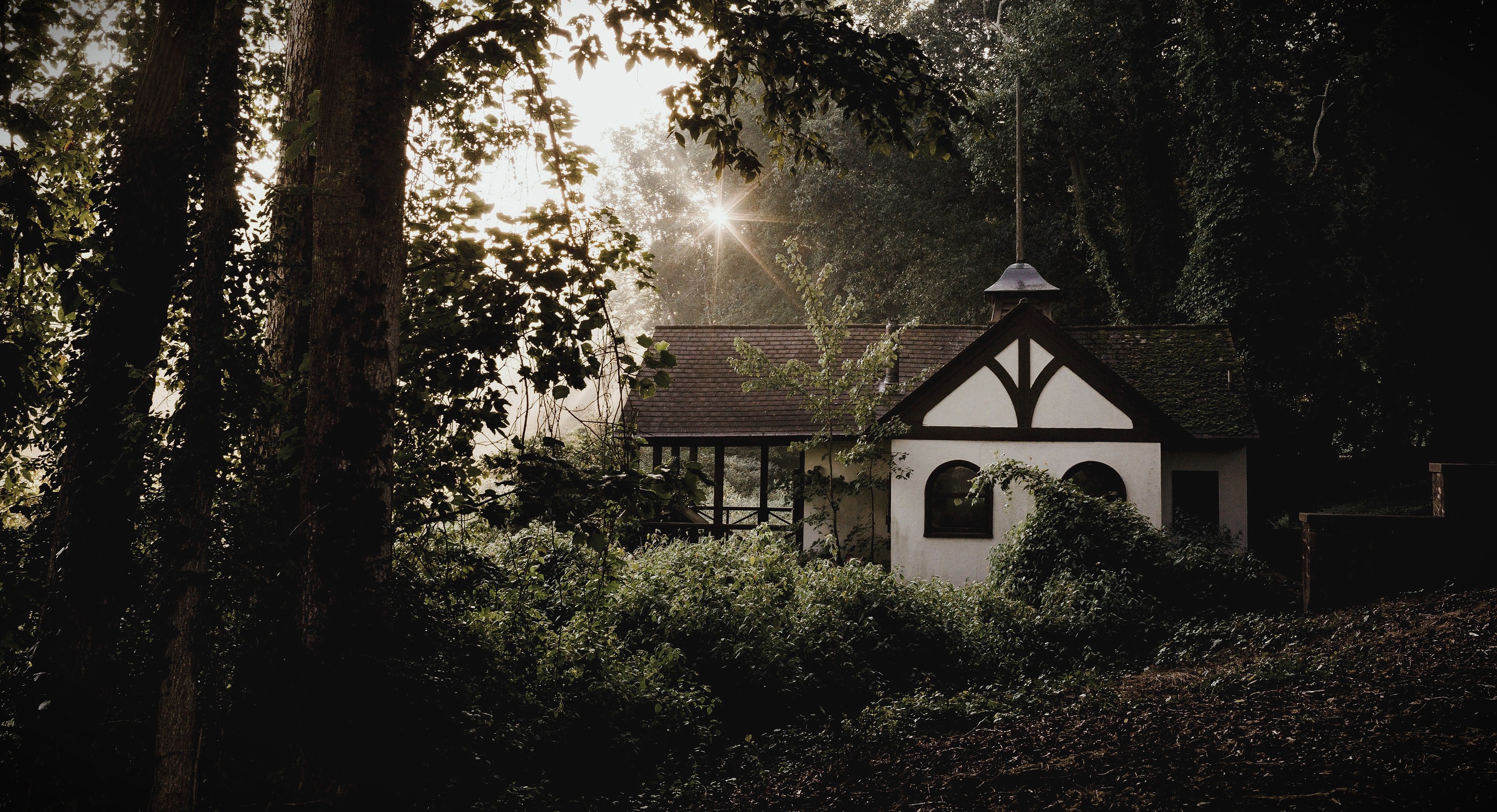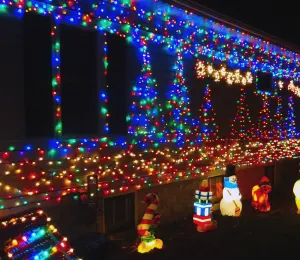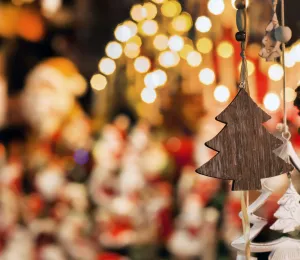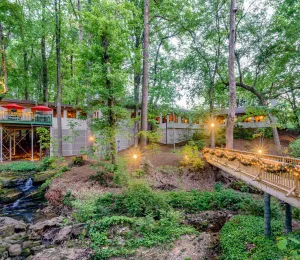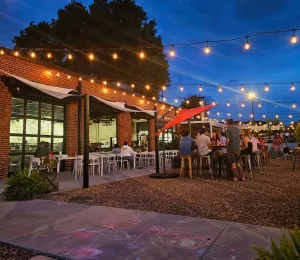Winston-Salem's Famous Ghost Stories & Haunted Sites
From Old Salem to Reynolda, come along as we explore five of the city's most haunted historical sites.
Winston-Salem has plenty of history—and plenty of ghosts to go with it.
From the “Lady in White” at Reynolda to Old Salem’s fabled “Little Red Man,” these legends still echo through the city’s most storied sites. Whether you’re a seasoned ghost hunter or simply curious, the five spots below invite exploration. And even if spirits aren’t your style, you’ll discover plenty of history, striking architecture, and atmosphere worth savoring..
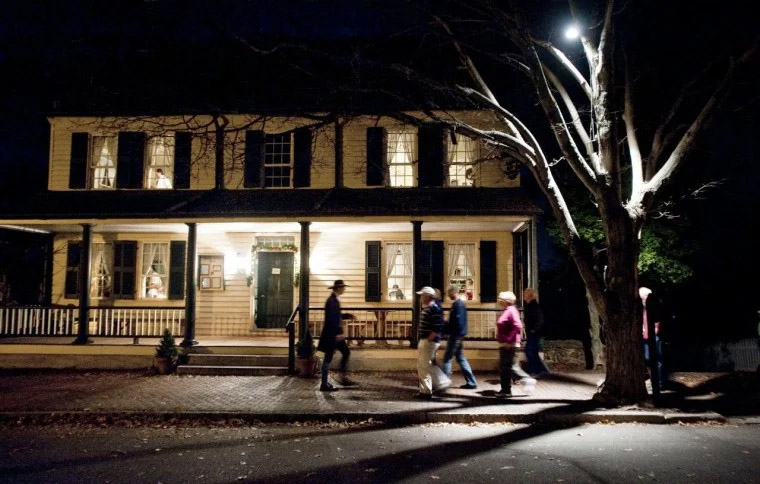
Old Salem
By day, Old Salem Museums & Gardens is one of America’s most authentic and immersive living-history museums. Costumed interpreters, working trade shops, and meticulously restored 18th- and 19th-century buildings capture the daily rhythms of the city’s first settlers—the humble, hard-working Moravians who arrived in 1766 seeking religious freedom. Famous for their meticulous record-keeping, the Moravians chronicled nearly every facet of community life—and even, at times, the afterlife. A few of those centuries-old tales still send a shiver through today’s visitors.
The Talking Corpse
One of Old Salem’s most enduring ghost tales unfolds at the Tavern Museum, once the settlement’s bustling public house. Built in 1784, the tavern welcomed merchants, travelers, and other non-Moravians who came to trade or purchase goods. Even President George Washington spent two nights here during his 1791 Southern tour. Today the Tavern Museum is open daily for tours, offering a glimpse of 18th-century hospitality and setting the stage for one of Winston-Salem’s most famous hauntings.
On a frigid November night in 1831, a stranger dressed in black checked into Salem Tavern, a popular inn for travelers that still welcomes visitors today. Gravely ill, he slipped into a coma and died the next day without revealing his name. His saddlebags were stored away, but soon workers heard eerie noises and felt a chilling presence. One evening, the innkeeper was confronted by a shadowy figure who gave his name and asked that his family in Texas be contacted. When the family replied, confirming his identity and requesting his belongings, the strange happenings stopped.
The Little Red Man
Perhaps the most famous ghost in all of Winston-Salem haunts the Single Brothers House, a large communal residence built in 1769 for the unmarried men of the Moravian settlement. By day you can tour its period workshops and living quarters; by night, the story grows darker. In 1786, a mischievous shoemaker named Andreas Kremser—known for his love of pranks—was digging a cellar beneath the house when the floor collapsed. Rescued but fatally injured, he died within hours and was buried in God’s Acre, the Moravian graveyard.
Soon after, residents reported hearing the rhythmic tap of a shoemaker’s hammer and glimpsing a small man in a red coat gliding through the corridors. Dressed in red the day he died, Kremser became known as the “Little Red Man.” For centuries, unexplained noises and sightings have been attributed to him. Today, the Single Brothers House serves as offices for Old Salem Museums & Gardens, and staff still trade stories of odd happenings attributed to this legendary trickster.
- Experience – Step inside the very buildings where Winston-Salem’s most chilling tales were born. During Old Salem’s seasonal Night Watchman Tours, costumed guides lead you by lantern light through original 18th-century structures to relive the stories of the Little Red Man, the Talking Corpse, and more. Designed for ages 10 and up, these 60-minute tours run for six nights—October 17–18, 24–25, and 30–31.
Historic West End
Just west of downtown, the West End neighborhood blends stately historic homes with eerie tales. Stroll these tree-lined streets any time of year or join a "West Endings" tour, a year-round ghost walk from Carolina History & Haunts. Tour leader Dan Riedel says, “You can’t throw a stone in West End without hitting something historic,” says tour leader Dan Riedel. “No matter where you’re standing, there’s a story.”
Among them: the supposed curse at the Zevely House (now Bernardin’s Restaurant), reported hauntings at the old Bahnson Mansion (now the Spring House Restaurant), and the last public hanging in town near the grand—but short-lived—Hotel Zinzendorf.
The most chilling account involves the former Frank Miller House during the 1918 Spanish flu outbreak. With hospitals overcrowded, the home became a temporary ward. While patients were quarantined inside, dozens of victims’ bodies were stored in the carriage house out back. The main house is long gone—replaced by a St. Paul’s Episcopal Church cemetery—but the carriage house remains. Visitors frequently report shadowy figures and mysterious orbs in photos. “People often sense something before I even tell the story,” Riedel notes.
- Experience – Discover the West End’s dark side on a Carolina History & Haunts ghost tour. This 90-minute, four-block walk blends spine-tingling stories with the neighborhood’s rich architectural history—and it’s offered year-round, making it a perfect way to explore Winston-Salem after dark.
Reynolda Estate
Reynolda is more than a grand estate—it’s a cultural centerpiece. Built in 1917 as the country home of tobacco magnate R.J. Reynolds and his wife, Katharine Smith Reynolds, the 1,067-acre property today houses the Reynolda House Museum of American Art, Reynolda Gardens, and a charming village of boutique shops and cafés. Visitors come year-round for acclaimed art exhibitions, lush garden strolls, and seasonal events.
But some whisper the grounds still keep their secrets. R.J. died of cancer just a year after the house was finished, leaving Katharine to oversee the estate until her death in 1924. Visitors tell of a “lady in white” who drifts through the gardens—sometimes on horseback, often wrapped in mist and an unseasonable chill. Most sightings center near the old boathouse and Lake Katharine, now a wetlands refuge. Could it be Katharine, still riding her beloved trails, keeping watch?
-
Experience (families) – Reynolda Pumpkin Patch Hayride (Oct 18). Little ones (ages 2–10) can enjoy a festive hayride through the meadow, explore hands-on pumpkin activities, and decorate their own pumpkin with natural materials from the gardens.
-
For All – Halloween Organ Spooktacular (Oct. 26). Step into the grand Reception Hall for spooky tunes played on Reynolda’s 1917 Aeolian organ, with Halloween décor inspired by Katharine Reynolds’s legendary parties. Music and other activities will take place 2–4 p.m.
Brookstown Inn
Built in 1837 as a cotton mill, the Historic Brookstown Inn is now a boutique hotel where history—and legend—still linger. The mill’s early days were marked by harsh working conditions and tragic accidents, and today many consider it one of Winston-Salem’s most haunted places.
Most ghostly tales focus on the fourth floor, long considered the building’s most mysterious level. Paranormal investigators flock here for the unexplained sounds and sudden chills. Room 401—once a workers’ dormitory—draws the bravest guests, said to host the restless spirit of Sally, who allegedly fell to her death after a confrontation with a co-worker. Others swear they’ve heard children’s laughter or the heavy steps of a spirit known as Eddie.
[And yes—Visit Winston-Salem’s own office sits right next door. We adore our neighbor, but even we feel a hush on that top floor, as if something unseen is holding its breath.]
-
Experience It: Nearly 200 years old, this former cotton mill now charms guests with exposed brick walls, cozy courtyards, and easy access to Old Salem’s Halloween happenings. Whether you’re here for the history or the hauntings, it’s a memorable place to spend the night—just beware if you book a room on the fourth floor....
Körner’s Folly
Billed as “the strangest house in America,” Körner’s Folly in nearby Kernersville looks tailor-made for hauntings. Built in 1878 by furniture designer Jule Körner as both family home and design showroom, the seven-level, 22-room marvel remained his ever-evolving masterpiece until his death in 1924. The Folly briefly served as a funeral parlor before opening as a tourist attraction, and visitors can still explore its twisting stairways and whimsical rooms today.
In 2009, a well-known paranormal group investigated and officially declared the property haunted. They recorded disembodied voices, moving furniture, and lights mysteriously flicking on and off. One investigator reported three taps on the head—the same eerie experience an HVAC worker had described years earlier. Author Amy Spease, in Ghosts of the Triad, believes the lingering spirits—likely Jule himself—are friendly, more mischievous host than true menace.
- Experience It: Open daily for self-guided tours—and private tours by appointment—Körner’s Folly invites you to climb its spiraling staircase and uncover hidden treasures at your own pace. You might even stir a reaction from Mr. Körner himself. For an extra dose of fun, return on October 31 for the Spirited Halloween Ball, an evening of Victorian-inspired revelry snacks, cocktails, music, tarot card readings, paranormal investigations, and more spooky fun.
More Halloween Fun Awaits
Halloween is just around the corner, and things are getting spooky in Winston-Salem. Embark on a ghostly tour, catch a thrilling live show, or bring your pup to a costume party. Whatever type of fun you’re after, you’ll find it here. Discover more Halloween events and blogs on our Halloween landing page.

